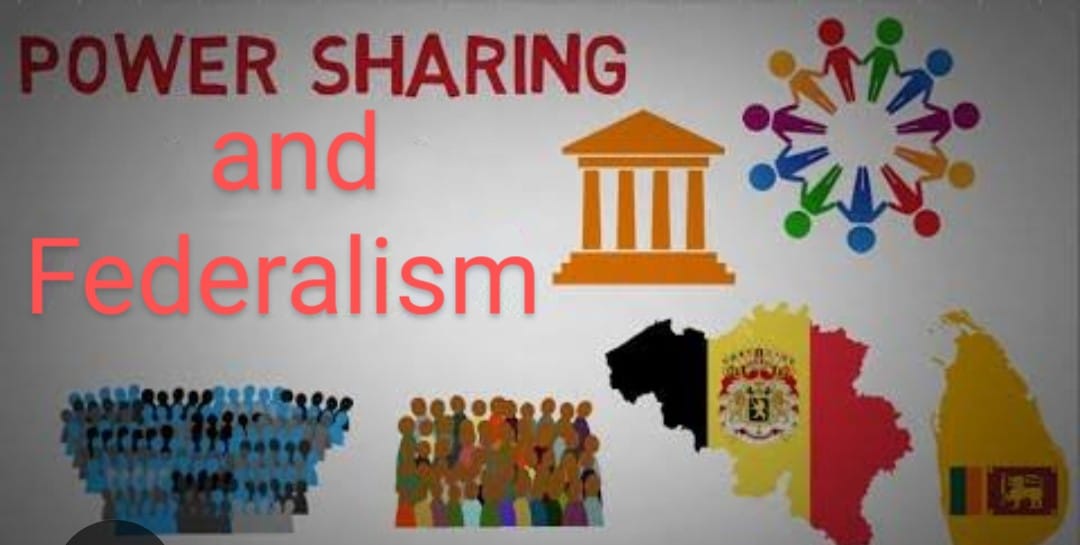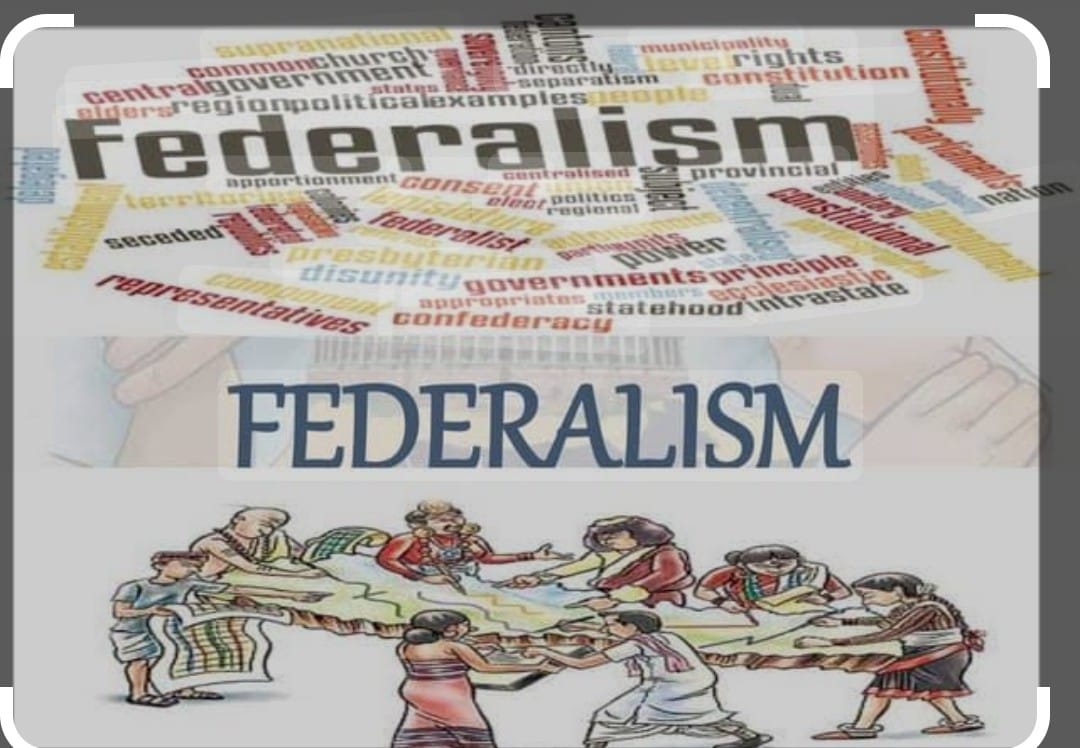Power Sharing and Federalism
Power Sharing and Federalism are 2 Chapters of Political Science of Social Science that covers the complete syllabus of class 10 give the basic idea of power sharing in the democratic government and division of powers in federalism.

Power Sharing

Most of the societies in the world are having diversities based on religion, race ,caste, language etc.so respect should be given to all the diverse growth and views that exist in society.
IN BELGIUM
59%population live in Flemish region speak Dutch,40%people live in Wallonia speak French. In the capital Brussels 80%are French speaking,20% are Dutch speaking. The minority of French speaking are rich and powerful this lead tension between two communities in1950 and1960 Dutch speaking were in majority in the country, but they were in minority in the capital Brussels, between1970and1993 four amendments were made in Belgium constitution so as to bring the arrangement that would enable everyone to live together peacefully within the country.
In fact Belgium59% were Dutch speaking,40%French speaking,1%German speaking but in Brussels 20%were Dutch speaking 80%were the French speaking at this complex situation Belgium government tried to remove the tension and took following steps
a. Equal number of Dutch and French speaking were appointed in the central
, government.
b. Large powers were given to the state government and made independent to take any decision in Favour of people more over they were made subordinate of central government.
c. Separate government was formed in Brussels where both the communities were having equal representation.
d. Community government was formed elected by particular language speaking community had power to take decision regarding culture, educational and language issue
In Sri Lanka
Sri Lanka is in south Asian region has the diverse population, she got independence in 1948. The population distribution are
a. Sinhala. 74%
b Sri Lakan Tamils. 11.1%
c. Indian Tamils. 12%
d. Muslims. 9.%
Now question arose that leaders of Sinhala wanted dominance over government by the virtue of majority that gave the birth to the issue of Majoritarianism which means that majority should be able to rule the country in any it wants with absolute power. Finally, the democratically elected government adopted the policy of majoritarian to establish its supremacy.
1956Act was passed in SriLankan in which Sinhala was recognized as official language Tamil language was disgraced.
Buddhism was given the state protection.
Sinhala applicants were preferred for university and for government jobs.
All these measures came one after another gradually created the feeling of alienation among the Sri Lakan and Indian Tamils The conflict started between the two communities which the shape of civil war, the violent conflict between the opposing group of same country
Why Power Sharing Desirable
There are two reasons.
a )Prudential Reason. It helps to reduce the possibility of conflict between social groups
It also ensures the stability of government.
b). Moral Reason. Spirit of democracy remain alive with the legitimacy of the government.
Forms of Power Sharing
There are three kinds of power Sharing
a.) Vertical distribution of power in this power is delegated from higher authority to lower one such as
Central government to state government. to local b
b.) Horizontal distribution of power
Having independent powers with check and balances such as Legislative, Executive, Judiciary
c.) Power may be shared by social groups on the basis of religion, pressure group, and political parties.
d. Community government was formed elected by particular language speaking community had power to take decision regarding culture, educational and language issue
In Sri Lanka
Sri Lanka is in south Asian region has the diverse population ,she got independence in 1948. The population distribution are
a). Sinhala. 74%
b) Sri Lakan Tamils. 11.1%
c). Indian Tamils. 12%
d). Muslims. 9.%
Now question arose that leaders of Sinhala wanted dominance over government by the virtue of majority that gave the birth to the issue of Majoritarianism which means that majority should be able to rule the country in any it wants with absolute power. Finally the democratically elected government adopted the policy of majoritarian to establish its supremacy
1956Act was passed in SriLankan in which Sinhala was recognised as offical language Tamil language was disgraced
Buddhism was given the state protection
Sinhala applicants were preferred for university and for government jobs
All these measures came one after another gradually created the feeling of alienation among the Sri Lakan and Indian Tamils The conflict started between the two communities which the shape of civil war , the violent conflict between the opposing group of same country
FEDERALISM

Federalism is a system of government in which the power is divided between central authority and various constituents of the country.
Usually, federations have two units:
a.) Central government: a government for the entire country which is
responsible for the matter of common national interests.
b). State Government: a government which looks after day to day affairs of
the state and are responsible for their administration.
Both the levels enjoy a certain level of powers and are independent of each
Unitary form of government: A system in which either there is a single government or there are levels of government which are subordinate to the main government.
In a federal government, no level is subordinate to the other and each enjoy equal powers other.
Features of federalism:
a). There are two or more levels of government.
b). Different levels govern the same citizens but each has its jurisdiction in
matters of legislature, taxation and administration.
c). Jurisdiction of each level of government is specified in the constitution.
d). Fundamental provisions about jurisdiction of the government cannot be unilaterally changed by a single level, it needs an approval of both the levels of government.
e). Courts have the authority to interpret the constitution and it is the duty of the Supreme court to settle disputes between different levels of government.
f). Sources of revenue are clearly specified in the constitution to ensure financial autonomy.
g). Federal system has mainly two goals: to safeguard and promote the unity of the country, while at the same time accommodate regional diversity.
There are two types of federations:
a). Coming together federations: when a number of states come together
to form a bigger unit to increase their sense of security.
All constituent states have equal powers.
Example: United States of America, Australia and Switzerland.
b). Holding together federations: when a large country divides its powers
between different states and the national government.
Central government has more power than states.
Example: India, Spain and Belgium.
India’s Federal system is divided in such a way that the powers are not just divided into two levels, rather three levels:
a. Central Government
b. State Government
c. Municipality and Panchayats.
Hence, the legislative powers are divided into three lists to clearly specify the
jurisdictions of each level of the government.
Union List(99 subjects):
It includes subjects of national importance i.e. Foreign
affairs, banking, defence, currency, etc
.
State List(61 Subjects):
It includes subjects of state and local importance i.e.
Police, Education, Healthcare, Trade, Commerce, Agriculture, etc.
Concurrent List(47 Subjects):
Some subjects in which both State and the Union
Government can make laws. However, Central laws will always prevail incase of
a dispute. It includes forest, marriage, adoption, etc.
There are other subjects which came to be after the constitution was drafted
such as computers, software, etc. These are called Residuary Subjects. These are governed by the Central Government.
India is a holding together federation hence, india does not give equal powerto all its states. There are some states which are given special status
according to article 371. For example: Nagaland, Arunanchal Pradesh and Mizoram.
There are special provisions given to protect the land and indegenios people and their culture. A non-resident of the state cannot buy land in these areas.
There are some units in the country which are too small to form a complete
state and cannot be merged with other states. These units are called Union
Territories. These units do not have a state government and are governed by
central government.
The powers of the state and central government cannot be changed directly
by the parliament. A bill needs to be passed by both the houses of the
parliament with 66% majority. It needs to be ratified by the legislature of half of
the total states.
HOW FEDERALISM IS PRACTISED IN INDIA?
The first test of making India a federal country was to develop Linguistic states. After 1947, many borders of different states were changed in order to ensure that people who spoke same languages lived in the same state.
Some states were not created on the basis of the language, rather to preserve the culture, ethnicity and geography. Example: Nagaland, Uttarakhand and Jharkhand.
The second test was Language Policy. Our constitution did not give the status of national language to any other language. Hindi is the official language of the country. However, it is spoken by only 40% of the population.
Hence, 21 other scheduled languages are present in the constitution. A candidate appearing for the central government examination may opt to give the exam in any of these 22 languages.
Most of the official work is also done in these languages.
Use of English was supposed to be stopped by 1965. However, many non Hindi speaking states revolted against the idea due to which one revolt in Tamil Nadu turned violent. Hence, the government decided to keep English for official purposes only. However, the central government cannot impose Hindi
on anyone.
COALITION GOVERNMENT:
The type of government in which there is more than one party which forms the ruling party. They tend to form a party
alliance with small regional party to form a government at the centre.
According to census 2011, there are 121 different languages in the country. Out of these 22 languages are in the eighth schedule of the Indian Constitution and are called Scheduled Languages.
Such languages which are not present in the eighth schedule are called Non Scheduled Languages.
.
Read More : Gender Religion and Caste
Read More : Outcomes of Democracy
Follow us on : Facebook